Disaster prevention
1. Earthquake
In addition to bridge collapse prevention measures, the MLIT accelerates other anti-seismic measures for expressways and national highways under the jurisdiction of MLIT to prevent a large surface gap, including reinforcement and replacement of supports, based on the probability of large earthquake. In specific, the ministry reinforces support of bridges for immediate recovery from damages and takes other measures where the reinforcement is not possible. Earthquake preparedness is scheduled as below:
-By the end of FY 2021: seismic reinforcement in areas with a probability of 26% or more is expected to complete (see the black areas in the map below)
-In 10 years: seismic strengthening for all areas across the nation is complete.
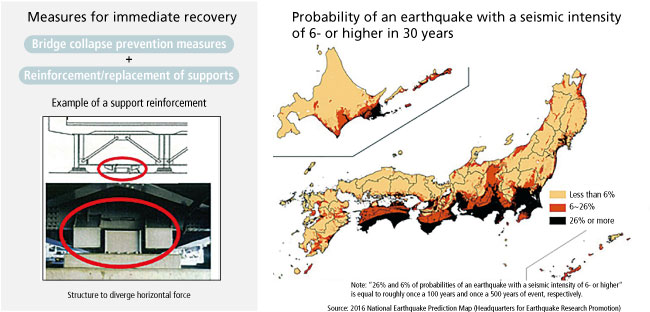
Implement bridge collapse prevention measures that add an ability of immediate recovery of functions.
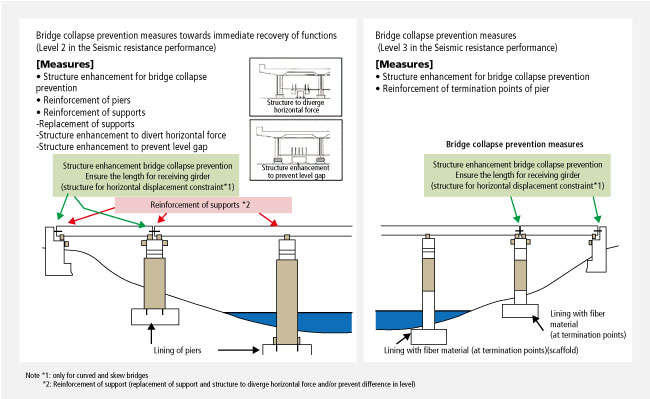
-Overpasses over expressways and national highways under jurisdiction of MLIT are given priority on the collapse prevention measures in the next 5 years (400 bridges are owned by local governments as of November 2016). .
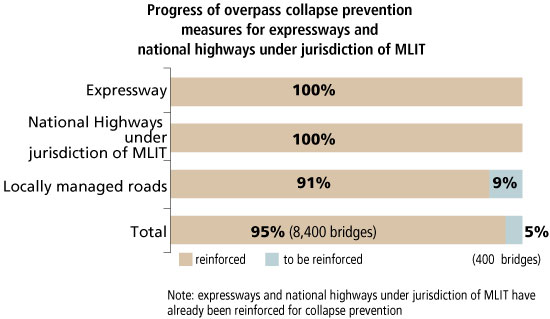
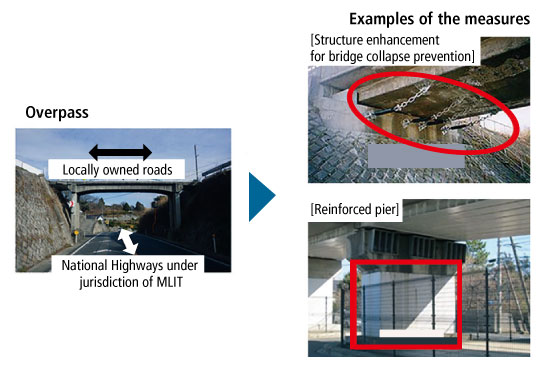
Seismic strengthening is conducted by the end of FY 2019 for bridges with rocking piers over expressways, national highways under jurisdiction of MLIT (450 bridges).
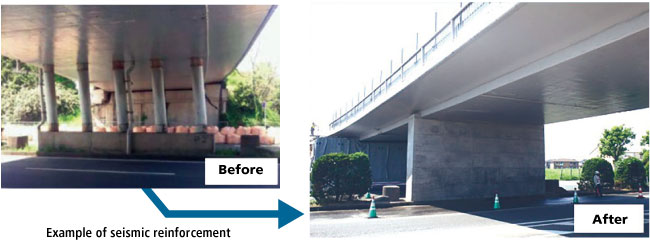
1. A bridge with rocking piers was collapsed by Kumamoto Earthquake. There remains the possibility that measures in the past were insufficient to avoid collapse, considering peculiarities of Kumamoto Earthquake (consisting of 2 strong quakes) and structure itself.
2. Several overpasses over expressways and national highways under jurisdiction of MLIT have not been reinforced for collapse prevention (completion rate is 91% as of November 2016 for those owned by local governments).
3. Although collapse prevention measures have been completed for all the emergency transportation routes (consisting of expressways and national highways under jurisdiction of MLIT), the seismic reinforcement (including reinforcement of bridge shoes) that promptly enables emergency transport vehicles to pass the routes has not been completed (completion rate is 77% as of March 2017).

2.Countermeasures for heavy rains
Following works are used for slope protection from a heavy rain.
-Rock fall prevention fence work: installation of fence to protect from rock falls. Fence is installed along the road to catch falling rocks.
-Pocket-type rock fall prevention net work: installation of a net to catch falling rocks where they start falling.
-Wire rope that tie a rock: the rope will fix some rocks that may fall in the future.
-Concrete crib work: covers and fixes a slope that may collapse in the future.
-Concrete crib + anchoring: in some cases, concrete structure is supported by additional anchors.
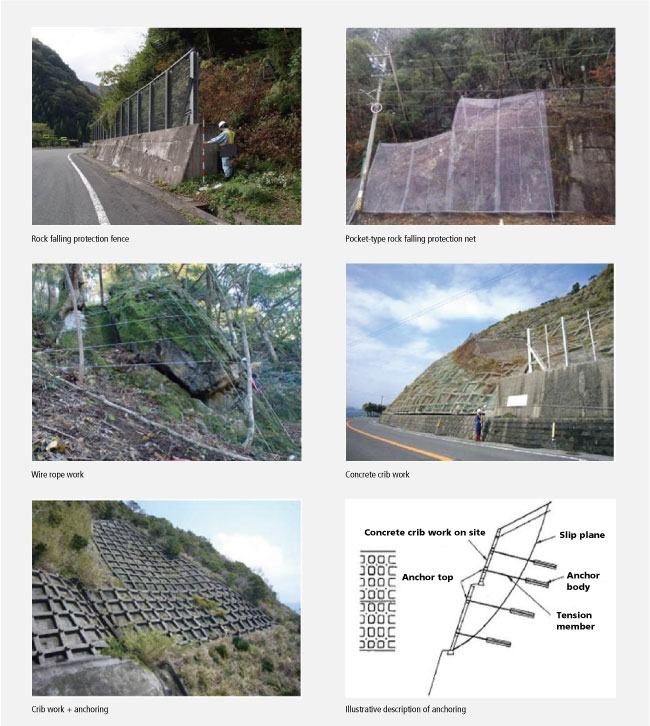
In the areas with frequent heavy rain, development of arterial high-standard roads is promoted to provide redundancy, rather than individual spot improvements. Given that overtopping waves frequently force to close National Highway No 7 around the border between Niigata and Yamagata, the Asahi-Atsumi Road is going to be developed as a high-standard road at a distant from the sea shore to ensure redundancy at the event of disaster and reliable transport between regions.
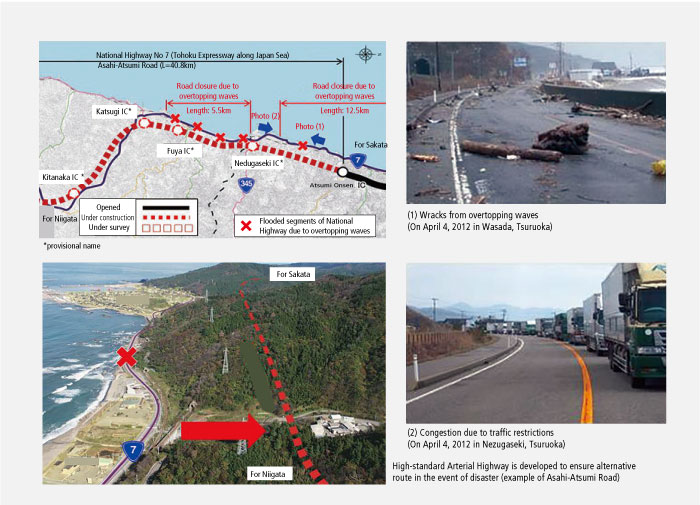
In urban areas, there are about 3,500 underpasses across the country as of April 1, 2015. A heavy rain exceeding the capacity of a drain pump under the underpass will make a pool on the underpass. In the event of such a heavy rain, we will close the road and provide information for road users.

3. Countermeasures for snowfall
About 60% of the country is in cold and snowy area where about a quarter of the total population lives.
-Although snowy areas in Japan are located at lower latitudes than many large cities in Europe and North America, they have a significant amount of snowfall with the similar snow depth*.
-A heavy snowfall causes avalanche and ice roads, resulting in slipping and congestion.
-To prevent these disasters, road administrators are responsible for ensuring stable road traffic during winter using antifreezing agent and other snow protection work.
-When heavy snowfall or blizzard may make vehicles stuck on the road, which block the emergency vehicles and constitutes a serious obstacle of emergency relief operation, road administrators will be entitled to remove those obstacles based on the Basic Act on Disaster Control Measures (amended in November 2014).
*Snow depth in Japan which is reported by MET may be measured differently from city snow depth data published on websites in other countries.
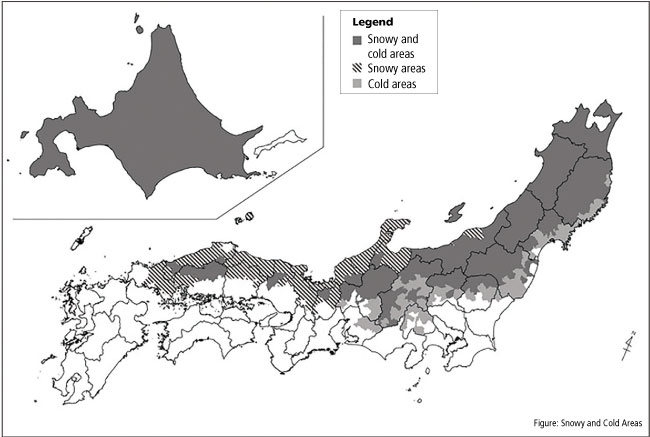

This refers to a section identified as a standstill-prone location in the event of heavy snow especially for heavy vehicles on a steep slope. This section receives intensive and efficient snow removal preferentially. 217 road sections were identified as priority snow removal section across Japan in FY 2016.
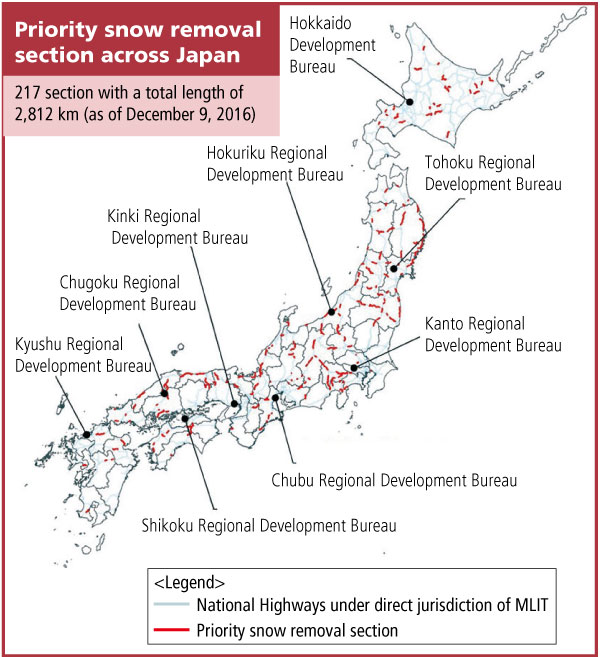

After the Kumamoto Earthquake in 2016, 50 locations were closed on the emergency transportation routes which extends to about 2,000 km in Kumamoto Prefecture. To ensure smooth freight transport whether it is a normal time or at the event of disaster, the MLIT is committed to improving accessibility to key locations as well as enhancing functions of arterial network to support stable economy and everyday life by supporting and investing on a priority basis.
-About 100,000 km of roads were designated as Emergency transportation routes which should ensure smooth emergency transportation
-As a countermeasure of aging roads, about 35,000 km of roads were designated as "recommended roads for trucks” which should guide heavy trucks to desirable routes and promote proper road usage
-Improve accessibility of last-mile roads to airports, ports, freight rail stations and other key logistics hubs by reviewing the rural high-standard highways.
-Establish an arterial network (including planned roads) by selecting from various and complicated current network and key locations
For the arterial network,
-reinforce road structures for quicker road reopening and recovery of alternative routes at the event of disaster and for extra large trucks
-more control over roadside usage by large-scale facilities through intensive support and investment
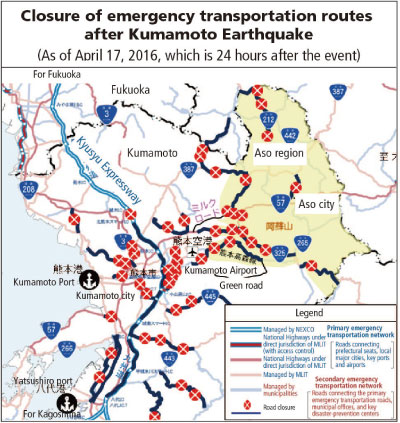
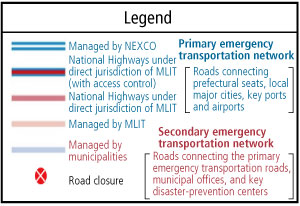
4. Recover from Natural Catastrophes and Reconstruction
-Dates: April 14 and 16, 2016, Seismic intensity: 7, Affected Area: Mashiki, Kumamoto Pref.
-National Highways No. 57 and 325 became impassable at several places by a catastrophic slop failure in Aso Ohashi district
-National Highway No. 325, the Prefectural Road and Town Road were redeveloped by the National Government on behalf of the original road administrators
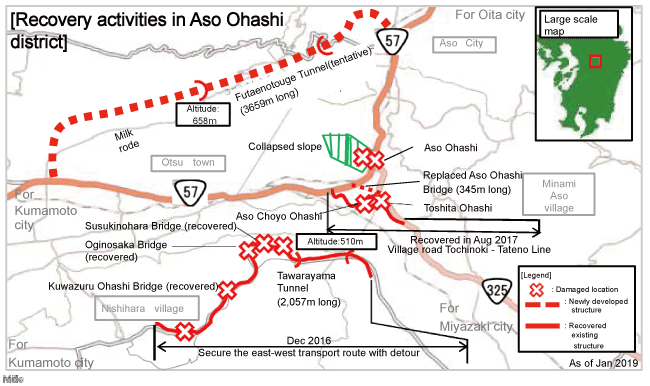
○National Highway No. 57 Northern Recovery Route and Aso Ohashi Bridge on the National Highway No. 325 are being rapidly redeveloped toward opening in FY2020.
Note : Refer to pages 49 and 50 for the overview of the Urgent Inspection of Strategic Infrastructure and Three-year Urgent Project.
-Dates: April 14 and 16, 2016, Seismic intensity: 7, Affected Area: Mashiki, Kumamoto Pref.
-National Highways No. 57 and 325 became impassable at several places by a catastrophic slop failure in Aso Ohashi district
-July heavy rainfall caused road closures at up to 1,500 locations on arterial roads.
-To mitigate congestion in the affected section between Hiroshima and Kure, BRT was provided and drivers on Sanyo Expressway were encouraged to avoid this section through adjusted tolls.
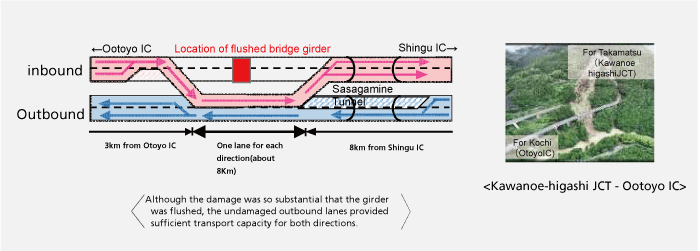
○The damaged section from the July heavy rainfall on Kochi Expressway is being redeveloped toward the reopening of 4 lanes
○The Kansai International Airport Access Bridge damaged by Typhoon Jebi (locally called "No.21") is being redeveloped to meet the target of full recovery by the early May holiday season in 2019
[A Three-year Urgent Project for Disaster-prevention/mitigation and Structural Strengthening]
○In the wake of the July heavy rainfall that caused severe damage, the MLIT started Urgent Inspection of Strategic Infrastructure*2 to stabilize slopes and embankment, remove utility poles and implement other urgent measures.

5.Securing traffic function during the severe rainfall in July 2018

-The Sanyo Expressway was closed, but Chugoku Expressway and San-in Expressway remained open to serve as main east-west arteries.
[The Chugoku Expressway had 5x more traffic than usual.]
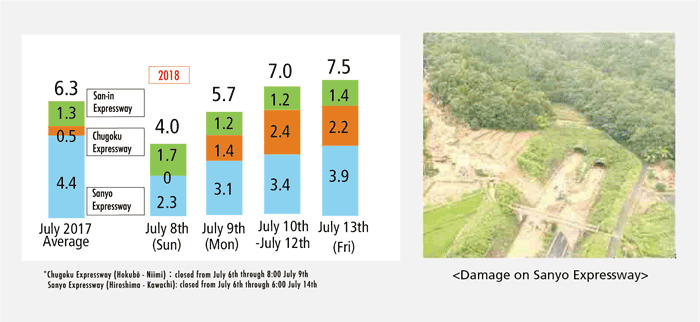
-Despite a bridge collapse on the inbound lanes, the traffic was restored with 2 temporary lanes in 6 days after the disaster, by utilizing the outbound lanes.
[2 lanes were temporarily in service in 1992, to be 4 lanes in 2008.]
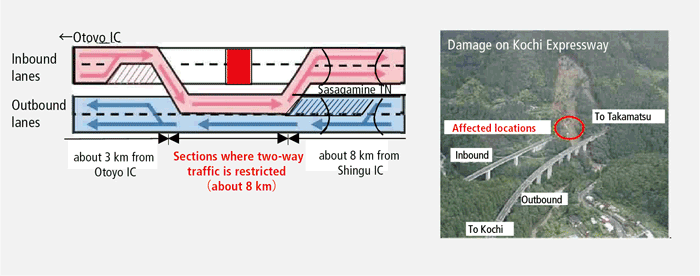
-By using Kyushu Road outbound lanes and Kitakyushu Road inbound lanes, 2 or more lanes were secured as the traffic line between Honshu and Kyushu.
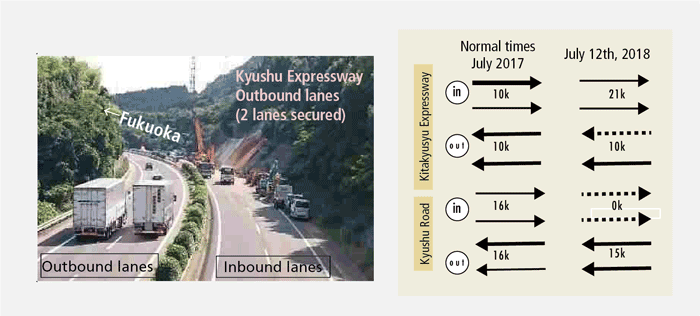
-Temporary use of the ICs on the Hiroshima-Kure Road, along with the early reopening of National Highway No. 31, allowed intercity buses to operate between Hiroshima and Kure.
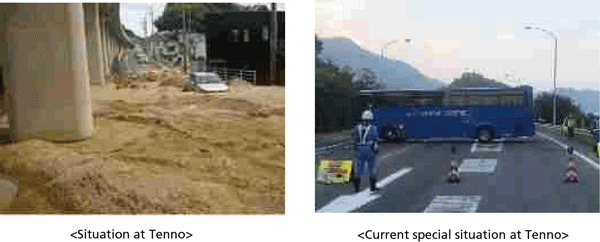
-Tree and mud debris, etc. fouled the main lanes, but 2 lanes were restored 3 days after the disaster to secure passage for transport vehicles.

